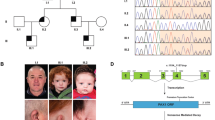Abstract
Autosomal dominant aplasia of lacrimal and salivary glands (ALSG; OMIM 180920 and OMIM 103420) is a rare condition characterized by irritable eyes and dryness of the mouth. We mapped ALSG to 5p13.2–5q13.1, which coincides with the gene fibroblast growth factor 10 (FGF10). In two extended pedigrees, we identified heterozygous mutations in FGF10 in all individuals with ALSG. Fgf10+/− mice have a phenotype similar to ALSG, providing a model for this disorder. We suggest that haploinsufficiency for FGF10 during a crucial stage of development results in ALSG.
This is a preview of subscription content, access via your institution
Access options
Subscribe to this journal
Receive 12 print issues and online access
$209.00 per year
only $17.42 per issue
Buy this article
- Purchase on Springer Link
- Instant access to full article PDF
Prices may be subject to local taxes which are calculated during checkout


Similar content being viewed by others

Accession codes
References
Wiedemann, H.R. Am. J. Med. Genet. 68, 222–224 (1997).
Ferreira, A.P. et al. Am. J. Med. Genet. 94, 32–34 (2000).
Bolstad, A.I. & Jonsson, R. Arthritis Res. 4, 353–359 (2002).
Young, W. et al. Oral Surg. Oral Med. Oral Pathol. Oral Radiol. Endod. 92, 38–48 (2001).
Milunsky, J.M., Lee, V.W., Siegel, B.S. & Milunsky, A. Am. J. Med. Genet. 37, 371–374 (1990).
Emoto, H. et al. J. Biol. Chem. 272, 23191–23194 (1997).
Makarenkova, H.P. et al. Development 127, 2563–2572 (2000).
Ohuchi, H. et al. Biochem. Biophys. Res. Commun. 277, 643–649 (2000).
Min, H. et al. Genes Dev. 12, 3156–3161 (1998).
Sekine, K. et al. Nat. Genet. 21, 138–141 (1999).
Vitali, C. et al. Arthritis Rheum. 36, 340–347 (1993).
Vitali, C. et al. Ann. Rheum. Dis. 61, 554–558 (2002).
Bagai, S. et al. J. Biol. Chem. 277, 23828–23837 (2002).
Yeh, B.K. et al. Proc. Natl. Acad. Sci. USA 100, 2266–2271 (2003).
De Moerlooze, L. et al. Development 127, 483–492 (2000).
Acknowledgements
We thank the family members that participated in this study, N. Hagwall and M. Wyon for ophthalmologic examinations and L. Cato and Uppsala Genome Center. This work was supported by grants to N.D. from the Swedish Research Council, Swedish Cancer Society, Childrens' Cancer Foundation of Sweden, the Torsten and Ragnar Söderbergs Fund, the Borgström Foundation and Uppsala University.
Author information
Authors and Affiliations
Corresponding author
Ethics declarations
Competing interests
The authors declare no competing financial interests.
Supplementary information
Supplementary Fig. 1
Magnetic resonance imaging of lacrimal and salivary glands. (PDF 58 kb)
Supplementary Fig. 2
Amplicons generated by long-range PCR of the FGF10 region in DNA from individual III:2 of family 1 and a control. (PDF 20 kb)
Supplementary Table 1
Summary of clinical examination of affected individuals in family 1 and 2. (PDF 10 kb)
Supplementary Table 2
Two-point lod scores between chromosome 5 markers and the locus for aplasia of lacrimal and salivary glands. (PDF 47 kb)
Rights and permissions
About this article
Cite this article
Entesarian, M., Matsson, H., Klar, J. et al. Mutations in the gene encoding fibroblast growth factor 10 are associated with aplasia of lacrimal and salivary glands. Nat Genet 37, 125–128 (2005). https://doi.org/10.1038/ng1507
Received:
Accepted:
Published:
Issue Date:
DOI: https://doi.org/10.1038/ng1507
This article is cited by
-
Deletion of the last two exons of FGF10 in a family with LADD syndrome and pulmonary acinar hypoplasia
European Journal of Human Genetics (2022)
-
Cell signaling regulation in salivary gland development
Cellular and Molecular Life Sciences (2021)
-
Evidence for lung repair and regeneration in humans: key stem cells and therapeutic functions of fibroblast growth factors
Frontiers of Medicine (2020)
-
Novel FGF10 mutation in autosomal dominant aplasia of lacrimal and salivary glands
Clinical Oral Investigations (2017)
-
Alveologenesis: key cellular players and fibroblast growth factor 10 signaling
Molecular and Cellular Pediatrics (2016)


